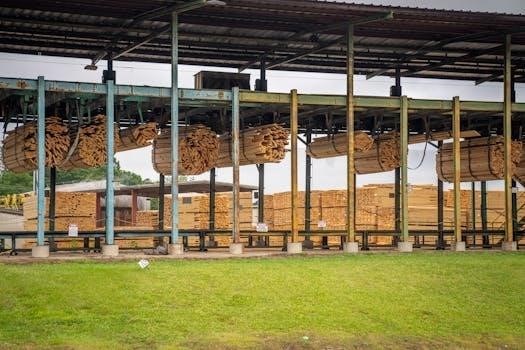
lumber storage cart plans pdf
Lumber storage carts are essential for organizing workshops, providing a mobile solution to manage various wood sizes, from long boards to sheet goods. These carts help maintain a tidy space and prevent lumber from warping.
The Need for Organized Lumber Storage
Disorganized lumber piles create chaos in any workshop, leading to wasted time searching for the right piece and increasing the risk of damage. Efficient lumber storage is crucial for maintaining a safe and productive workspace. Without a proper system, wood can warp, become inaccessible, or get mixed up with other materials. A dedicated storage solution, such as a lumber cart, helps keep different sizes and types of wood separate and easy to identify. This not only saves valuable time but also ensures that lumber is stored in a way that preserves its quality and usability. Investing in a well-designed lumber storage system is a step towards a more efficient and enjoyable woodworking experience. It also reduces the frustration of dealing with cluttered spaces and helps make the most of your available workshop area. A tidy workshop is a more productive workshop.

Key Features of Lumber Storage Cart Plans
Effective lumber cart plans prioritize mobility, offering casters for easy movement. They also cater to various lumber sizes and maximize space efficiency with a small footprint, essential for compact workshops.
Mobility and Casters
The cornerstone of a well-designed lumber storage cart is its mobility, primarily achieved through the use of casters. These wheels allow the cart to be easily moved around a workshop, which is particularly beneficial in small or crowded spaces. The ability to relocate a fully loaded lumber cart is crucial for efficient workflow and space management. Casters come in various sizes and load capacities, and selecting the right ones is essential to ensure smooth and safe movement. For heavier loads, it is important to use robust casters with a higher weight rating. Swivel casters are often preferred for easy maneuverability, allowing the cart to be navigated around obstacles. Some designs even incorporate locking casters to provide stability when the cart is stationary. The integration of these features allows for versatile movement of lumber and sheet goods within a workspace, making it easier to access and manage wood.
Storage for Various Lumber Sizes
A well-designed lumber storage cart must accommodate a variety of lumber sizes, including long boards, shorter pieces, and sheet goods. The storage solutions typically include shelves for longer lengths, vertical bins for shorter pieces and a dedicated area for sheet materials. Shelving units are essential for keeping long boards organized and accessible. These shelves can be designed to be adjustable to accommodate different lumber thicknesses. Vertical bins are ideal for storing shorter pieces, and these compartments often have dividers to separate different types of wood. The sheet good storage area usually consists of a large, flat space or vertical slots, allowing for the easy storage of plywood and other sheet materials. This combination of storage solutions ensures that all types of lumber can be neatly stored, maximizing space within the cart. Such versatility is critical to the functionality of a lumber storage cart.
Space Efficiency and Small Footprint
Lumber storage carts are designed to maximize space utilization in workshops, often featuring a compact footprint. A key design consideration is to achieve a large storage capacity while occupying minimal floor space. The vertical design of many lumber carts is ideal for this, as it allows for the efficient use of vertical space, reducing clutter and creating more room in the work area. A small footprint allows the cart to fit even in smaller workshops and garages. The design often incorporates strategic shelving and storage solutions that make the most of every available inch of space. The compact nature of these carts also means that they can be easily moved and positioned in different parts of the workspace as needed, without taking up too much room. This ensures that the available space is utilized efficiently.

DIY Lumber Cart Construction
Building a DIY lumber cart involves carefully selecting materials and tools, followed by step-by-step construction. This process allows for customization to fit specific needs and available workspace.
Materials and Tools Required
Constructing a lumber storage cart necessitates a collection of specific materials and tools. Commonly, one would need plywood, often a single sheet can suffice for a basic design, alongside 2×4 lumber for the frame’s base. Essential fasteners include screws of various lengths, ensuring sturdy joints. For mobility, heavy-duty caster wheels are crucial, often four in number, with some being lockable for stability. Wood glue is a must for reinforcing joints, enhancing the cart’s overall durability.
Measuring tools such as a tape measure and a square are vital for accurate cuts. A circular saw or table saw is needed for cutting the plywood and lumber, while a drill or impact driver is used for fastening screws. Safety gear, including safety glasses and gloves, is paramount. A pencil is needed for marking and a level for ensuring the structure is true.
Step-by-Step Building Instructions
Begin by cutting the plywood and lumber to the specified dimensions according to your chosen plan. Assemble the base frame using 2x4s, ensuring square corners and secure joints with screws and glue. Attach the caster wheels to the base, making sure they are firmly fixed and properly aligned for smooth movement. Next, cut and attach the plywood panels to form the sides and shelves of the cart, using glue and screws. Ensure that all panels are flush and securely fastened to the frame. Install any interior dividers or bins for scrap wood, following the plan’s specifications. Add cleats or supports where needed to enhance the cart’s structural integrity. Finally, inspect all joints, and make any necessary adjustments for stability. Allow the glue to dry thoroughly, and your cart is ready for use.

Specific Design Considerations
When planning your lumber cart, think about how to store sheet goods efficiently. Consider adding bins and dividers for scrap wood to maximize your storage and organization.
Sheet Good Storage
Integrating sheet good storage into your lumber cart design is crucial for maintaining organization and preventing damage. Many plans feature a dedicated section, often a vertical slot, designed to accommodate plywood, MDF, and other large, flat materials. This vertical orientation not only saves space but also helps to prevent warping that can occur when sheet goods are stored horizontally; The size of this section will depend on the typical dimensions of the sheet goods you use, but it’s often beneficial to design it to handle standard 4×8 foot sheets. Some designs also incorporate dividers within this section to further organize different types or thicknesses of sheet materials. The proper design ensures easy access and prevents the need to move multiple sheets to get to the one you need. This dedicated space prevents these large pieces from cluttering your workspace.
Scrap Wood Bins and Dividers
Efficient scrap wood management is essential for any workshop, and lumber storage carts often incorporate bins and dividers to keep these smaller pieces organized. These bins can be constructed from plywood or other materials and are typically designed to be easily accessible. Dividers within the bins help sort scraps by size, species, or project type, which prevents them from becoming a chaotic pile. Angled tops on the bin dividers can provide easier access and visibility of the contents. Some designs use dowels or cleats to further divide the space, allowing for a more granular level of organization. Implementing these features ensures that even small offcuts are readily available and don’t get lost or overlooked, reducing waste and enhancing workflow. A well-organized scrap wood system can significantly improve the overall efficiency and tidiness of your workspace.

Free Plans and Resources
Numerous online resources offer free lumber cart plans in PDF format, along with video tutorials and guides. These resources help woodworkers easily construct their own storage solutions.
Where to Find PDF Plans
Locating free PDF plans for lumber storage carts is quite straightforward, thanks to the abundance of resources available online. Many woodworking websites and blogs offer downloadable plans, often as a free resource to their readers. These plans typically include detailed cut lists, assembly instructions, and diagrams to guide you through the building process. You can often find these plans on sites dedicated to DIY projects, woodworking, and even some maker communities. Some popular platforms and websites that host these plans include personal blogs of woodworkers, online woodworking forums, and even some tool manufacturer websites. When searching for plans, be sure to use keywords like “free lumber cart plans,” “DIY lumber storage cart,” or “rolling lumber cart PDF.” Always check the comments or reviews of the plans to ensure they are easy to understand and follow, and that they meet your specific needs for size and storage capacity. These plans are designed to make construction efficient and effective.
Video Tutorials and Guides
Complementing PDF plans, video tutorials and guides offer invaluable visual assistance for building lumber storage carts. These videos often demonstrate each step of the construction process, making it easier to understand the techniques and assembly methods. Platforms like YouTube are a treasure trove of woodworking content, with numerous channels dedicated to DIY projects, including lumber cart builds. Many video tutorials not only show the construction process but also provide tips and tricks for material selection and customization. Some tutorials might even offer alternative construction methods or design modifications. When searching for video guides, use specific keywords like “DIY lumber cart tutorial,” “how to build a rolling lumber cart,” or “plywood storage cart build.” These videos can help clarify any confusion from written plans and provide a more engaging learning experience. Be sure to watch multiple videos to understand different approaches before beginning your project.

Leave a Reply
You must be logged in to post a comment.